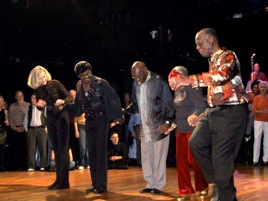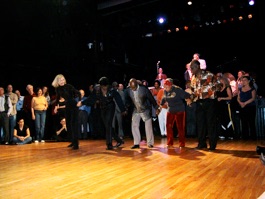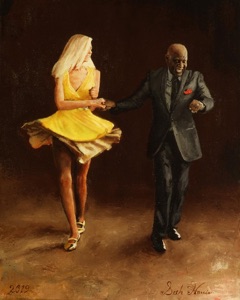DVDs & Master’s Thesis “the Lindy”
A review of the Written Thesis at bottom of page
DVDs & Master’s Thesis “the Lindy”
A review of the Written Thesis at bottom of page

Lindy Instructional DVDs & Videos
$50 each:
• Beginning Lindy
• Intermediate Lindy
• Advanced Intermediate Lindy (VHS only)
• Lindy Swing Outs (VHS only)
• Lindy Syncopations (VHS only)
Other Instructional Videos
$40 each:
• Shim Sham
• Jitterbug Stroll
Masters Thesis DVDs & Videos
$60 each; $240 for complete set, which includes a free copy of the written thesis. Each video is approximately 2 hours, or more, in length:
Tape 1: Frankie Manning
Tape 2: George Lloyd
Tape 3: Charlie Meade
Tape 4: Tom Lewis
Written Thesis
$20 each:
“The Lindy”, Margaret’s 104 page New York University master’s thesis covers the origins and evolution of the Lindy, and the various dance styling of four excellent Lindy dancers: Frankie Manning, George Lloyd, Charlie Meade and Tom Lewis. Each dancer is the focus of one the four two-hour+ videos, that cover their dancing, personal history and views about the Lindy.
Read the Review of “The Lindy” by George Woolley.
Shipping Charges
• $5 for a single DVD or video
• $10 for 2 to 4 DVDs or videos
• $10 for written thesis alone
• $20 for complete set of thesis DVDs including written thesis
* ($5-$20 additional charge per category for shipping outside USA depending)
Payment Terms
• Check or cash accepted
• There are no refunds or exchanges
If paying by paypal theremay be additional charges, please ask before sending
Send payments to:
my paypal is paypal.me/margbat
or mail it to by check to
Margaret Batiuchok
504 East. 63rd Street / #35-R
New York, NY 10065
A Review of Margaret Batiuchok's "The Lindy"
by George Woolley
Dance Magic Review December 1997
Although written in fullment of a degree requirement at NYU, the thesis is primarily a work of art. It is a celebration of Lindy and of great Lindy dancers. It is also a work in progress that the reader can participate in by engaging with the questions Margaret raises & the material she provides and by being open to be inspired to dance better.
Contents
The written part of the thesis is 104 pages long and addresses such topics as: the characteristics of Lindy, the origins and evolution of Lindy, and characteristics of the dancing of four excellent Lindy dancers. The thesis also includes four video tapes, each over two hours long, and each focusing on an excellent Lindy dancer's dancing, personal history and views about Lindy. The dancers are Frankie Manning, George Lloyd, Charlie Mead, and Tom Lewis. Also included on the tapes are clips of demos and of dancing in social settings in New York City.
Vision
Margaret brings forth a vision of Lindy. It is grounded on the one hand in clear intellectual distinctions and on the other hand in the videos of the dancing of excellent Lindy dancers. She sees Lindy as a jazz dance danced to swing music with a certain syncopation and a certain feel. Excellent Lindy dancers express themselves in the moment through their dancing. They improvise within the structure of the dance, have their own personal styles, and have a deep connection with their partners and the music.
Grounding
In the Chapter on her "Artistic Aim", Margaret describes the dancing of the four dancers. The descriptions are detailed and yet quite moving. If her descriptions have merit, then her view of excellent Lindy dancers is grounded. The videos give concrete validation to Margaret's views. Frankie, George, Charlie and Tom each have their own styles, improvise within the structure of the dance and are connected with the music and with their partners.
Intention
It is Margaret's intention that we see the artistry of the four dancers she focuses on and the possibilites that Lindy holds for us of developing our own styling and creativity.
Levels of Abstraction
At one level of abstraction, we could copy the dancing of Frankie Manning down to the exact angle of his back in each move. On a higher level of abstraction, we could be like all four of the dancers that the thesis focuses on by developing our own styles, improvising within the structure of the dance, etc. We cannot do both. It is Margaret's aim that we do the latter, that is, that we learn the structure and feel of Lindy, and then develop our own way of dancing it within the structure of the dance.
© Copyright 1997 George Woolley
Painting to left by Seth Harris







